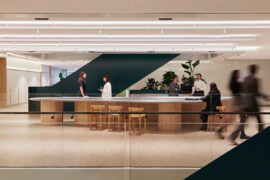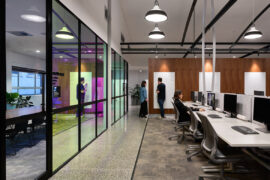Dr Stephen Long of Architectus takes us to the Queensland outback where The Eromanga Natural History Museum houses ‘Cooper’, Australia’s largest known dinosaur.

Dr Stephen Long, principal and national sector leader, public, at Architectus.
May 3rd, 2022
The Eromanga Natural History Museum houses a fascinating and highly significant paleontological collection from South West Queensland. In 2018, Architectus was appointed to design the first stage of a new facility to share the museum’s activities and collection with the public and to provide research facilities for staff and visiting researchers.
Eromanga is a small town in Quilpie Shire with a population of less than 100 and is considered by many to be the farthest town from the sea in Australia. Eromanga sits in the Great Artesian Basin – the largest and deepest artesian basin in the world. The watercourses around Eromanga flow into the famous channel country of Cooper Creek that drains toward Lake Eyre. The museum has played a vital role in elevating the town to a popular remote destination that attracts tourists, palaeontology enthusiasts, researchers and volunteers keen to support the museum.
In 1997 palaeontologists from the Queensland Museum were drawn to Eromanga by geological mapping, which suggested that dinosaur fossils could be found in the region. Their initial search did not produce results, but still sparked interest among locals. Six years later, while mustering sheep on his parents’ property, Sandy Mackenzie came across what his mother and museum co-founder, Robyn Mackenzie, described as a “red spongey-looking rock” that was the size of an adult fist (ABC, 2019). The property they lived on, along with Robyn’s husband Stuart Mackenzie, was one of the first organic sheep stations in South West Queensland. It was also once home to one of the largest dinosaurs in Australia – possibly on earth – approximately 95 million years ago.

This fossil was the origin of the museum. When palaeontologists in Brisbane confirmed the rock was, in fact, fossilised dinosaur remains, the museum’s founders (pastoralists who live west of Eromanga), took a deep dive into dinosaurs and fossil preservation to care for the precious artefact. They developed skills that would help them run the museum and enable them to continue searching for prehistoric remnants that would grow the collection.
Further fossils were located at the site of the original find of a dinosaur that became known as ‘Cooper’. Cooper was recognised by palaeontologists as a new species, Australotitan cooperensis in June 2021. A dinosaur can be measured by the mass or length of its fossils. Going by length, Cooper is the largest dinosaur to have ever been discovered in Australia. By mass, Cooper would be the second largest known dinosaur in the world.
Designing a natural history museum
The museum sits on Boonthamurra Country, on a low ridge line with an existing foundation building and lodge to the south, Mulga to the west, a line of bloodwood trees at the interface of the ridge line and an open plain to the east. To the north, the site looks out over gilgai and an open floodplain towards town.
The client had a clear vision for their museum: they wanted a contemporary concrete building with enduring qualities and a design that would transform the space into a world-class natural history museum. Erring away from the classic red colour tones found in western Queensland, the client sought a building inspired by the washed-out, subtle tones found in black soil country, grass plains and vegetation. The building’s grey precast concrete walls have a subtle boarded concrete pattern that creates a softening effect of light and shade. The grey concrete sits beautifully in the landscape with its elegant, clean lines. The building heightens the experience of the surrounding landscape.

Visitors approach the museum through a linear entry pavilion sitting beneath a dramatic concrete roof cantilevered from concrete blades. The pavilion aligns the approach to the building with views out to the stand of bloodwood trees. This view alignment was walked with the client and pegged out to ensure it was captured in the design. During the warmer months, the pavilion provides deep shade and a welcoming sense of arrival in the hot climatic conditions of Eromanga. In winter, the pavilion welcomes with a pool of sunlight and shelter from the cold, dry, southerly winds.
The first stage of the museum development is an entry building housing a reception, office, shop, cafe, theatre, gallery and courtyard. The grey concrete walls and honed concrete floor of the reception area are illuminated with the diffuse light of a clerestory high above and windows onto the entry pavilion. The reception area and cafe are scaled to accommodate guided tour groups commencing and completing their museum experience.
The cafe has two captivating views that are framed by deep sunshade elements. The first is a view towards the east and the stand of bloodwood trees. The second is out to the open plain to the north. An exhibition gallery leads visitors from the reception and cafe area to the theatre, where a film introduces them to the history of dinosaurs and megafauna in the area and the associated research activities. Visitors are guided through the Museum in small groups of 25. Visitors then move from the new buildings to the foundation building, where the bulk of the collection is stored.
Related: OMA’s design for WA Museum Boola Bardip

A further stage, a research building, has recently been constructed to support the museum’s research activities. There are three laboratories where fossils are prepared (by removing surrounding rock away from the fossil itself). There are also storage facilities for dinosaurs and megafauna fossils.
The building has been designed with temporary walls to allow for connection to the future main gallery space that is planned between the research building and the arrival building. The future main gallery will feature internal glazed partitions so that visitors can view the prepping laboratories and storage areas.
The next stage of the museum development is to create the main gallery space located between the entry building and research laboratories. The gallery will be a dramatic column-free space featuring a full-scale replica of Cooper, which will stand seven metres tall and span up to 30 metres in length. The replica will be illuminated by soft, diffuse natural light in combination with gallery lighting to create a memorable museum experience.
Working in a remote location
Collaborating with clients on a remote project is remarkably different to many city-based projects. Architectus has established a strong working relationship with the museum staff, including members of the Mackenzie, Pegler and Richards families and the Quilpie Shire Council team, all of whom welcomed Architectus into the tight-knit local community. These close relationships generated ideas, aspirations and design responses.
The construction typology and materials for this project were carefully considered in response to the remote location and extreme climates. While off-form concrete was initially preferred for the project, the team decided to use pre-cast concrete for most of the building as it provided better quality control and ensured that concrete pours were not impacted by extreme weather. Pre-cast panel sizes were then carefully considered to minimise the number of trucks required to deliver the panels to the site. The museum team were excited to see the first precast panels installed because they represented many years of planning and effort to secure funding for the project.

Architectus project lead, Stephanie Donigi, brought extensive experience to the project, in particular her learnings from working on the PNG National Museum & Art Gallery. Donigi deeply understood the importance of designing and documenting remote buildings as a way of ensuring that construction would not be hindered by remote access, especially when trades needed to revisit the site on multiple occasions. The approach also involved developing a close working relationship with the contractor so that any issues raised on site could be dealt with efficiently while maintaining the design intent. The project builders, New State Builders, are proud of their work, and the project provided locals with the opportunity to upskill.
Environmental impact, cultural heritage, economic viability and social significance
The museum’s remote location presented a number of sustainability challenges that were addressed in the design. Eromanga can experience temperatures below 0ºC in winter and close to 50ºC in summer. The building envelope is designed to insulate from these extreme conditions with a build-up of pre-cast concrete panel externally, air gap and insulation and internal concrete panel. External glazing is minimised, but where it occurs, high performance glazing is used to reduce glare and heat load. With no air conditioning running, the envelope creates internal conditions that are significantly cooler than external conditions on a hot day and in winter, the building does not need to be heated.
The mains power supply available to the site is limited, which resulted in the need for a high performing building envelope and the need to carefully consider the type and context of electrical and mechanical services within the building. The new building features a rooftop solar array to supplement the power supply. The museum hopes to create its own solar farm so that it can access a self-sufficient power supply.

The new building maintains a self-imposed 15-metre clearance from the stand of bloodwood trees. Overland flows were also considered to ensure that during rain events the stand of trees continue to receive water running off the ridgeline.
A piece of history
The Eromanga Natural History Museum is a simple yet elegant design of enduring quality. It is a confident concrete form that sits comfortably in its surrounding landscape. The design of the building enhances the visitor experience and provides a supportive and inspiring work environment for staff and volunteers.
Architectus is proud to be helping the museum realise its dream of becoming a state-of-the-art natural history museum with the future development of the main gallery space.
This article was authored by Dr Stephen Long, principal and national sector leader, public at Architectus, and originally published by Architectus. Team acknowledgments: Rachel Cox, Joe Feng, Morgan Lui, Kaela Wallace, Peter Grealy, Greg Allis, Mark Hogan.
Architectus
architectus.com.au
Photography
Courtesy of Architectus
INDESIGN is on instagram
Follow @indesignlive
A searchable and comprehensive guide for specifying leading products and their suppliers
Keep up to date with the latest and greatest from our industry BFF's!

At the Munarra Centre for Regional Excellence on Yorta Yorta Country in Victoria, ARM Architecture and Milliken use PrintWorks™ technology to translate First Nations narratives into a layered, community-led floorscape.

Now cooking and entertaining from his minimalist home kitchen designed around Gaggenau’s refined performance, Chef Wu brings professional craft into a calm and well-composed setting.

Law is one of the oldest professions in the world but Architectus’ new design for Ashurst Sydney’s workplace at 39 Martin Place reflects and responds to contemporary shifts.

Architectus’ new headquarters for Q-CTRL addresses complex technical requirements while creating an enjoyable place to work.
The internet never sleeps! Here's the stuff you might have missed

Tadao Ando’s Setouchi Retreat Aonagi conjures luxury through concrete, light, silence and a deeply immersive relationship with nature.

Suupaa in Cremorne reimagines the Japanese konbini as a fast-casual café, blending retail, dining and precise design by IF Architecture.